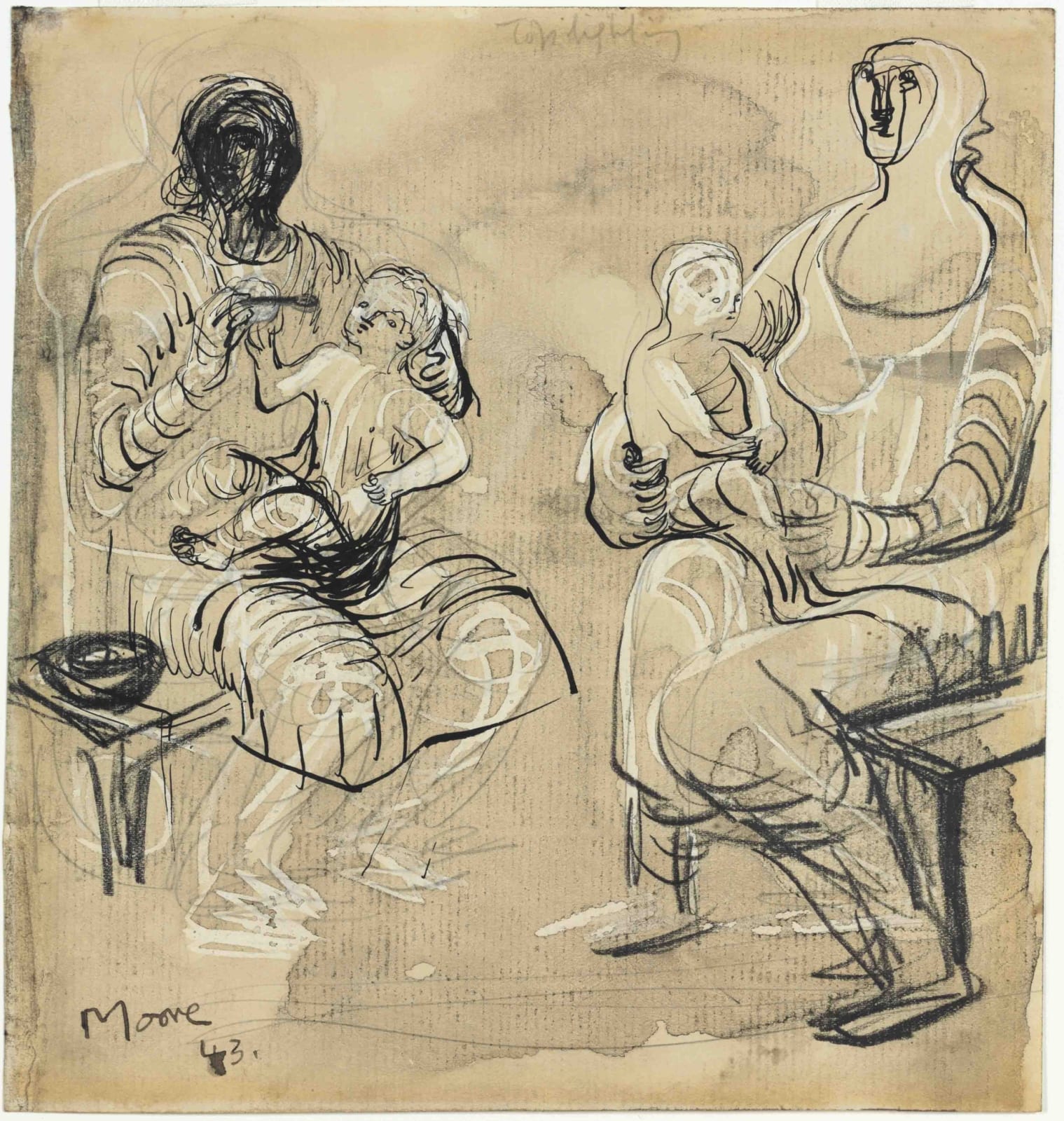Henry Moore
Madonna and Child Studies, 1943
Pen, India ink, watercolour, coloured wax crayons and pencil on paper
7 ¼ x 6 7/8 in, 18.4 x 17.5 cm
Signed and dated lower left and inscribed 'Top lighting' upper centre
Sold
In 1943 Moore was commissioned to carve one of his most celebrated sculptures: the Hornton stone 'Madonna and Child' for St. Matthew's Church, Northampton. Moore was at first reluctant, having...
In 1943 Moore was commissioned to carve one of his most celebrated sculptures: the Hornton stone 'Madonna and Child' for St. Matthew's Church, Northampton. Moore was at first reluctant, having not created any sculpture for almost two years. This drawing belongs to a series of important sketches from the period when he was deciding whether to proceed with the project and experimented with ideas connected with it.
Moore was naturally excited by the commission because of his preoccupation with the mother and child motif: “From very early on I have had an obsession with the Mother and Child theme. It has been a universal theme from the beginning of time and some of the earliest sculptures we’ve found from the Neolithic Age are of a Mother and Child”. At this time Moore was also trying with his wife for a family of their own and so it had a deep personal significance for him.
Yet Moore realised that the Madonna and Child would be something quite different from an everyday mother and child: `It's not easy to describe in words what this difference is, except by saying in general terms that the Madonna and Child should have an austerity and a nobility, and some touch of grandeur”. In this study he has emphasised the majestic pose of the Madonna who is imagined in imposing, strong terms, seated upright as she appears in the sculpture.
Moore was nevertheless intent on portraying Mary as a mother would appear to her son. Recalling his 'Shelter Drawings', in which families huddle together, Moore celebrates the intimacy between parent and child. In both poses he has emphasised the mother’s protective role as she holds the small child who is seated firmly on her knees. There is also a tenderness and humility to the sensitively drawn images; the Madonna’s touch is gentle, through which Moore has captured “the human feeling” he was intent on expressing in the hugely significant stone sculpture.
Moore was naturally excited by the commission because of his preoccupation with the mother and child motif: “From very early on I have had an obsession with the Mother and Child theme. It has been a universal theme from the beginning of time and some of the earliest sculptures we’ve found from the Neolithic Age are of a Mother and Child”. At this time Moore was also trying with his wife for a family of their own and so it had a deep personal significance for him.
Yet Moore realised that the Madonna and Child would be something quite different from an everyday mother and child: `It's not easy to describe in words what this difference is, except by saying in general terms that the Madonna and Child should have an austerity and a nobility, and some touch of grandeur”. In this study he has emphasised the majestic pose of the Madonna who is imagined in imposing, strong terms, seated upright as she appears in the sculpture.
Moore was nevertheless intent on portraying Mary as a mother would appear to her son. Recalling his 'Shelter Drawings', in which families huddle together, Moore celebrates the intimacy between parent and child. In both poses he has emphasised the mother’s protective role as she holds the small child who is seated firmly on her knees. There is also a tenderness and humility to the sensitively drawn images; the Madonna’s touch is gentle, through which Moore has captured “the human feeling” he was intent on expressing in the hugely significant stone sculpture.
Provenance
Pierre Loeb Gallery, Paris
Lee Kolker, New York (acquired c.1950)
Sale: Anon., Sotheby & Co., London, 16 December 1964, lot 127
Pita Kapnek, Johannesburg (acquired Sotheby & Co., London, 13 December 1967, lot 185)
Vanderwoude Tananbaum Gallery, New York
Private Collection (acquired from the above in January 1986)
Literature
Ann Garrould (ed.), Henry Moore, Complete Drawings 1940-49, vol. 3, London, 2001, p.195, no. AG 43.102, illus. p.194
